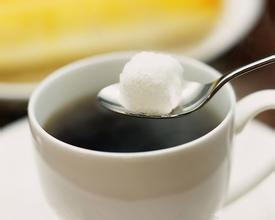Coffee excipients Coffee companion is also called vegetable fat

I. Coffee partner
Coffee companion, also known as vegetable fat, is a kind of plant hydrogenated oil, which is bad for human health and easy to make people fat, so they should eat as little as possible. At first, people drink coffee by hand, and then add fresh milk, sugar or other drinks to form a variety of different flavors. Simple coffee tastes bitter. If some coffee companions are added to the coffee, the taste will become delicious and rich in a variety of flavors.
Nowadays, instant coffee sold in the market is very popular, especially among young people, so there are "coffee companions" at the end of the plant (such as Nestl é). The list of ingredients for this companion indicates that the coffee companion plant is composed of glucose syrup, hydrogenated vegetable oil, sodium caseinate, stabilizer, emulsifier and anti-caking agent. In other words, coffee companion is the end of the plant, and the end of the plant is commonly known as "cream". The end of the plant is solid vegetable fat, that is, vegetable oil.
The vegetable fat in this coffee companion ingredient is a relatively healthy unsaturated fatty acid, but it is particularly prone to oxidation and decay and is difficult to be preserved for a long time. Therefore, in the food process, unsaturated fatty acids should be made into saturated fatty acids, and stabilizers, emulsifiers and anti-caking agents should be added to ensure that the cured fat particles are uniform, non-cohesive and stable in quality. suitable for storage and long shelf life. In other words, it eventually becomes saturated fatty acid and contains a lot of additives. Therefore, the impact of this kind of coffee partner on human health is self-evident.
2. Milk and cream
Usually people like to drink coffee with sugar and milk, or cream. Choosing different milk products can give the coffee a different flavor and enjoy the varied taste.
1. Fresh cream, also known as whipped cream. This is a high concentration of cream that separates fat from fresh milk and has a wide range of uses, such as making butter, ice cream, cakes, or making coffee. The fat content of whipped cream is as high as 45% Mel 50% and the lowest is 25% Mel 35%. Coffee is usually made with whipped cream with a fat content of 25% Mel 35%.
To identify the quality of cream, you can refer to the following points: (1) shape: the packaging still maintains its original shape after opening, there is no oil spill, and the quality of cream with smooth surface is better; if deformed, and oil spill, uneven surface, deflection and surrounding depressions are inferior cream. (2) Color: high-quality cream is transparent and yellowish, otherwise it is inferior cream. (3) smell: high-quality cream has a special aroma. If there is sour taste, bad smell, it is spoiled cream. (4) when the high-quality cream is cut with a knife, the cutting surface is smooth and there are no water droplets. Otherwise, it will be inferior cream. (5) the cream must be stored in cold storage equipment, and the suitable temperature is in the range of-5 ℃-5 ℃. Therefore, when buying, you should see whether the temperature of refrigerated goods display cabinets and other refrigerated equipment has the management conditions below 10 ℃ degrees. (6) taste: high-quality cream can dissolve in the mouth without roughness, otherwise it is inferior cream. (7) according to the year, month and day of manufacture, the flavor of cream will not change within 6 months when the cream is kept below 10 ℃.
2. Foamed cream: whipped cream turns into foamed cream after stirring and foaming. This cream tastes best with bitter espresso.
3. Condensed milk: concentrate the milk 1-2.5 times to become sugar-free condensed milk. Generally speaking, canned condensed milk sold in stores is heated and sterilized, but it is easy to rot after opening cans and cannot be preserved for a long time. When brewing coffee, whipped cream floats a layer of oil on the coffee, while condensed milk precipitates into the coffee.
4. Milk and cream: milk is suitable for blending espresso or fancy coffee, while cream is easy to use and easy to preserve. But no matter what kind of product you use, you can make a delicious cup of coffee according to your personal preference. When fresh cream is added to coffee, if there is a feathery oil on the surface, this is due to the phenomenon of fat separation when high-fat fresh cream is added to sour coffee or when stale dairy products are used. So in addition to paying attention to the freshness of dairy products, high-fat whipped cream should be mixed with coffee with a mild sour taste.
Third, the purpose of adding sugar to sugary coffee is to ease the bitterness, and according to the amount of sugar, it will create a completely different flavor. Powdered sugar: it belongs to a refined sugar, has no special taste, is easy to dissolve, and is usually easy to use in 5-8 grams. The price is a little higher than ordinary sugar.
Sugar cube: add water to the refined sugar and then solidify it into a lump. The cube sugar is easy to preserve and easy to dissolve.
White granulated sugar: White granulated sugar is also a refined sugar, it is coarse crystal solid, white color. There are more than 8 grams of small packaging in the market for each use.
Black sugar: this is a kind of brown sugar, a bit scorched, commonly used in the preparation of Irish coffee.
Rock sugar: transparent and crystalline, light sweetness and insoluble. It is usually ground into fine particles for use in drinks such as coffee or flavored tea.
Coffee sugar: sugar used specifically for coffee, brown sugar or cube sugar. Coffee sugar stays sweeter on the tongue than other sugars.
Fourth, other excipients coffee according to local people's feelings and preferences, so there are many different ways to drink coffee, at the same time in order to improve the taste of coffee, and use a variety of additives. Used for seasoning and decoration of flavored coffee, enriching the new enjoyment of coffee.
1. Spices: cinnamon (divided into powder or stick), cocoa, cardamom, mint, cloves, etc., of which cinnamon is often used in cappuccino.
2. Fruit: oranges, lemons, pineapples, bananas, etc., used for flavoring and decoration of fancy coffee, enriching the alternative enjoyment of coffee.
3. Alcohol: brandy, whisky, rum, peppermint liqueur, etc., is the magician of fancy coffee.
Important Notice :
前街咖啡 FrontStreet Coffee has moved to new addredd:
FrontStreet Coffee Address: 315,Donghua East Road,GuangZhou
Tel:020 38364473
- Prev

The Discovery of Coffee and the Coffee Culture of Coffee all over the World
The Discovery and spread of Coffee how was coffee discovered? When people taste mellow coffee, they can't help but ask such questions. According to Roth de Neroy, a Roman linguist, around the sixth century AD, an Arab shepherd named Caldai was very excited and excited to see every goat when he went to graze on the grasslands of Ethiopia. It made him
- Next

Standard process of bar production
Schematic diagram of the operation flow of the bar: prepare the order, prepare the equipment for feeding, make the inspection equipment, recover, clean and return to the position 1, accept the order standard operation: the order should be taken by the bar director and the foreman, and arranged in turn according to the order, morning and evening order. Note: 1) students are not allowed to take orders, and bar teachers are not allowed to take orders without the permission of their superiors. 2) the recipient should pay attention to the order at all times.
Related
- Beginners will see the "Coffee pull flower" guide!
- What is the difference between ice blog purified milk and ordinary milk coffee?
- Why is the Philippines the largest producer of crops in Liberia?
- For coffee extraction, should the fine powder be retained?
- How does extracted espresso fill pressed powder? How much strength does it take to press the powder?
- How to make jasmine cold extract coffee? Is the jasmine + latte good?
- Will this little toy really make the coffee taste better? How does Lily Drip affect coffee extraction?
- Will the action of slapping the filter cup also affect coffee extraction?
- What's the difference between powder-to-water ratio and powder-to-liquid ratio?
- What is the Ethiopian local species? What does it have to do with Heirloom native species?

